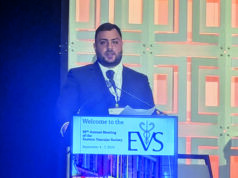
The President’s Symposium at the Vascular Society of Great Britain and Ireland (VSGBI) annual scientific meeting (Nov. 23–25) in Brighton, England, saw Rob Sayers, MD, from the University of Leicester, presenting, “CLTI CQUIN [Commissioning for Quality and Innovation] has raised the profile of PAD and will lead to fewer amputations.” Sayers’ take-home message for delegates was that the National Health Service (NHS) Commissioning for Quality and Innovation (CQUIN) for chronic limb-threatening ischemia (CLTI) will prove a valuable package of measures when it comes to raising awareness of peripheral arterial disease (PAD) and improving outcomes for patients, but that the question now lies in “how best we measure [these improvements].”
The CQUIN, Sayers began by outlining, was started in April 2022, and the premise of it is for the NHS to give “financial rewards for excellence [in the hope] that that translates into better patient outcomes.” The presenter noted, with relevance to the VSGBI audience, that their society had made sure to inform all its members of the CQUIN at its launch, and that the Society’s own PAD quality improvement framework (QIF) is complementary in its patient outcome focus.
Then providing background to the CQUIN process, Sayers shared that “you are more likely to be successful if your bid is patient-focused [and it is easy to implement],” adding that it is “competitive.” The resulting financial incentive that a successful bid bestows “depends on the size of your unit,” Sayers proceeded, and in the case of the CLTI CQUIN, “most [units] will receive between £500,000 and £1.5 million.”
Speaking to the merits of the CLTI CQUIN, Sayers described it as a “well written and clear proposal,” adding that there are benefits for patients.”
Moreover, the successful application could perhaps be set against the backdrop of “a lot of support from the NHS for various vascular services […which were] particularly hard-hit by the pandemic.” Sayers went on to stipulate that “[this] was noticed, and we became a protected specialty.”
Regarding the conditions of the CLTI CQUIN funding, “it requires you to revascularize patients within five days of referral,” Sayers detailed for the symposium audience.
“If you revascularize 60% of your patients within five days, you get the full payment, and if you revascularize less than 40%, you do not get any money at all.” The amount awarded for achieving results in between these benchmark figures is graduated, Sayers expanded.
Data monitoring is key to the CQUIN’s operation, delegates then heard. This is carried out “by local commissioners who compare data such as HES [Hospital Episode Statistics], and NVR [National Vascular Registry…] so if you were tempted to underreport, that would be spotted,” Sayers cautioned.
Moving on to address how the CQUIN can help patients, Sayers underlined that the goal is to “raise awareness of PAD and the PAD QIF, and CLTI, among clinicians and managers.” This then increases the chance of reinvestment to improve services, such as limb salvage clinics.
As of April 2023, the CQUIN will be up for renewal, Sayers conveyed, and the decision will be based on a number of factors, including whether participating units themselves “found [it] worthwhile.” However, there are limitations when it comes to how successful the CQUIN may be at achieving improved outcomes: “It requires very reliable data capture,” Sayers admitted. It “may [also be argued that] the targets are challenging” and “not particularly evidence-based,” he furthered.
Sayers rounded off by taking a long and wide view of VSGBI’s role in putting patients at the heart of members’ work and calling successive presidents to prioritize data gathering to facilitate this.
Maintaining relationships with exam boards so that the specialty adheres to “very good” professional standards was also among Sayers’ pieces of advice.
“There is no doubt that the Society needs to continue to foster its good relationship with NHS England,” he asserted, before opining that “work with commissioners” can “no doubt” serve as a solution to the problem of the post-COVID vascular services backlog.
Questions following the symposium centered on data monitoring and the quality of datasets, which reflected Sayers’ message that this is pivotal in the success of measures like those comprising the CLTI CQUIN.
In addition, Sayers was posed the question of whether “in order to ensure the development and appropriate investment in CLTI management, do you think some units will need to take one for the team and fail?” The presenter responded by referring to the “current data” from the CQUIN—“there are 55 units in England that are eligible for the CQUIN scheme [of whom] about 10–12 are currently below the threshold of 40% and [there are] probably another 5% [whose data] we do not [have].”
He reiterated that the CQUIN is “about improving your service to improve outcomes for patients,” and concluded, therefore, that those units that are currently falling short have the choice “whether they want to try to improve things for patients,” rather than it being about “taking one for the team.”












